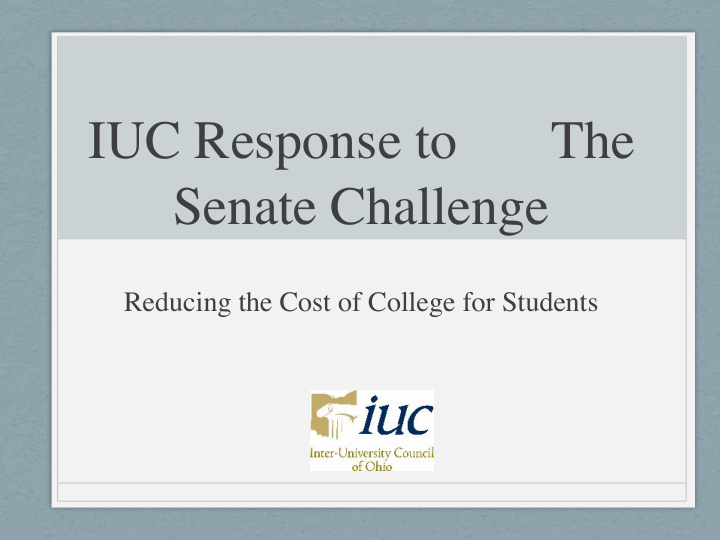



IUC Response to The Senate Challenge Reducing the Cost of College for Students
The Senate Challenge Reduce College Costs For Ohio Students by 5% While Continuing to Improve Quality 2
Talent Gap Imperative Source: The Lumina Foundation, “A Stronger Nation Through Higher Education” 3
Reducing Time to Degree • Time is the enemy – and time is money • The longer a student is in school, the higher the cost will be (and the higher student loan debt will be) • The most effective way to contain college costs for students and their families is to reduce the time it takes to earn a degree 4
“Time to Degree” Cost Drivers • Too much time taking non-credit remedial courses • Inadequate course loads to stay on track & on time • Excessive degree requirements • Accumulating more credits than necessary to earn degree or certificate • Unavailability of required courses • Lost credits due to changing majors 5
Too few credits in each semester • Nationwide, 70% of community college students referred to remedial math had not attempted a college- level math course within two years Source: Community College Research Center, Teachers College, Columbia University • Nationwide, just 29% of community college students and 50% of university students take the credits they need to graduate on time (15 credits per semester, 30 credits per year) Source: Complete College America and Postsecondary Analytics, “How Full-time Are ‘Full-time’ Students?” 6
Excess Credits Drive Costs Up 7
Delayed Graduation “Tax” 8
Full-Time Status Yields Big Dividends 9
Bottom Line • Graduating late costs students and families tens of thousands of dollars • Reducing time to degree could save students and families more money than a 5% cut in tuition will save them • Nearly 60,000 Ohio 4 year students were “full time” but not taking enough hours to graduate in 4 years. 10
University Actions to Reduce Time to Degree • Reduce number of credit hours required to graduate • Mount a “15 to Finish” campaign • Embed remediation in credit-bearing courses • Reinvent academic advising (intrusive advising) 11
University Actions to Reduce Time to Degree • Implement default scheduling • Offer fast-track degree programs • Make mathematics courses more relevant by aligning them to majors 12
State Actions to Reduce Time to Degree • Provide resources for quality career advising in high school so students can consider their academic choices before enrolling in college • Enact HB 1 (Workforce Grant program), which includes requirements and incentives for “on time” progress • Enact SB 6 (Jones/Eklund bill), which increases the state income tax deduction incentive for saving for college 13
State Actions to Reduce Time to Degree • Require each university to supplement its College Completion Plan with a plan to reduce time to degree • Support an Innovation Fund to provide grants for innovative programs that reduce time to degree (Gov. $20m) • Provide adequate resources to the K-12 sector for the College Credit Plus program (Gov. plus $5m) 14
Cost Savings For Students • The cost to the student of each additional year is $69,166 • Cost of attendance: $23,839 • Cost of lost wages: $45,327 • For every 1,000 students who avoid an extra year: • Potential savings for cost of attendance: $23,839,000 • Potential savings in additional wages: $45,327,000 • Additional State income taxes @3% rate: $2,751,500 15
Student Tuition Rebate • Provide tuition rebate/discount of up to 5% for students who complete 30 semester hours in the academic year. • State Incentive 75% • University Incentive 25% • Applied as financial aid the semester following the completion of 30 hour • Limited to 5% of the actual student fees paid. 16
Cost Estimate • University students who earned 30+ credit hours = 89,338 • 5% rebate of instructional fees for those 89,338 = $27,478,000 • Additional students likely to take advantage of incentive = 58,328 • 5% rebate for additional students=$16,180,000 • Students likely to take advantage took > 24 credits so they are technically full time, but not on track. 17
Total Cost to State and Universities • Total Rebate Cost = $ 43,658,000 • State of Ohio Cost = $32,743,500 • University Rebate Cost = $10,914,500 18
Questions? 19
Recommend
More recommend